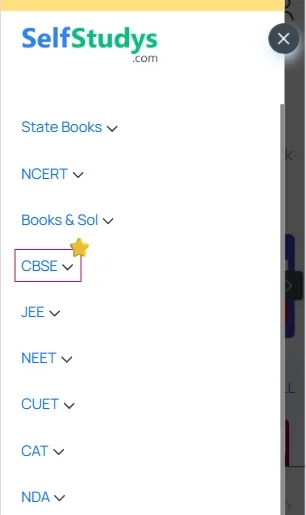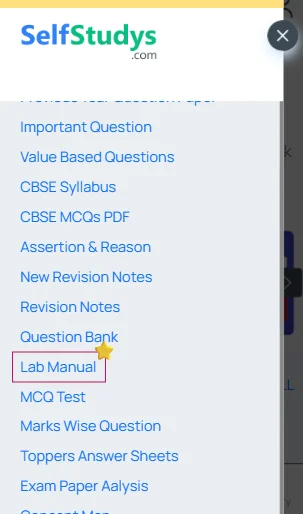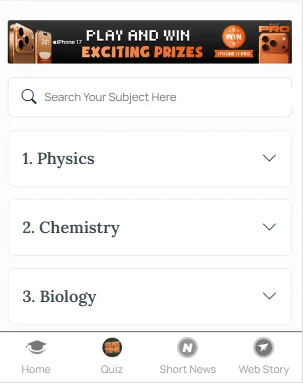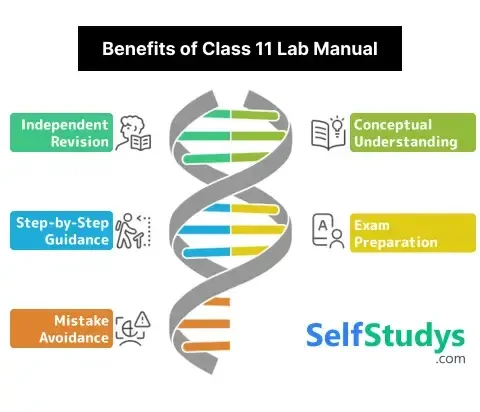-
1. Physics
- 0. Physics
- 1. General Introduction
- 2. Measurement of Length
- 3. Measurement of Mass
- 4. Measurement of Time
- 5. Vector Addition
- 6. Motion Under Gravity and Acceleration due to Gravity
- 7. Friction
- 8. Motion of a Body Down an Inclined Plane
- 9. Elasticity
- 10. Atmospheric Pressure
- 11. Surface Tension
- 12. Viscosity
- 13. Thermal Expansion of Solids
- 14. Thermal Expansion of Liquids
- 15. Thermal Radiation
- 16. Heat
- 17. Wave Motion and Velocity of Waves
- 18. Vibration of Strings and Air Columns
- 19. Activities
- 20. Experiment
-
2. Chemistry
- 0. Chemistry
- 1. Introduction
- 2. Basic Laboratory Techniques
- 3. Determination of Melting Point
- 4. Determination of Boiling Point
- 5. Purification of Chemical Substances by Crystallisation
- 6. Experiments Based On pH Change
- 7. Effect of Change of Concentration on Chemical Equilibrium
- 8. Quantitative Estimation (Volumetric Analysis)
- 9. Qualitative Analysis
- 10. Detection of Elements in Organic Compounds
- 11. Experiment
- 3. Biology
At the learning platform of SelfStudys, you get these manuals completely free, and you can use them to enhance your understanding as well as perform well in the lab sessions.
The lab manual Class 11 2025-26 is prepared to make your learning easier, clearer, and more engaging. Every experiment that you perform in the lab builds your analytical thinking, observation skills, scientific temper, and so on. These skills are important not only to excel in your academics but also in the future competitive exams.
What Makes A Good Lab Manual Class 11 2025-26?
A high-quality CBSE Class 11 lab manual is not just a collection of experiments. It is a companion that guides you through practical science step-by-step. A good lab manual, just like the one available on SelfStudys, should make your concepts clear as well as prepare you for the practical exams in a confident way. Here are some points on what makes this manual truly effective.
- Our NCERT lab manual Class 11 includes a proper explanation of the underlying concept for each experiment. With this, you are able to understand why you are doing the experiment and not just the how. Once you know the aim and scientific principle, you can perform the lab work with confidence.
- In the Class 11 practical lab manual, you will get instructions that are easy to follow with steps till the final outcome. Also, the language is quite simple to make sure that every step can be performed in the school lab.
- Diagrams that are well-labeled are very important in practical understanding. And in the Class 11 lab manual book at SelfStudys comes with clear circuit diagrams, neat instrument sketches, microscopic illustrations, graph templates, and so on. All these visuals will help you complete the records accurately as well as understand the apparatus usage in a better way.
- The best Class 11 practical manual, just like ours, lists the practical precautions. For example, specific cautions, like ‘rinse the burette with the solution before filling’ will be understood clearly than ‘handle chemicals carefully.’
- It is seen that many students struggle with reading the instruments or writing the observations. That’s why in our lab manual Class 11 PDF, you will get sample tables, correct readings, and units so that you can compare your results as well as learn the correct pattern.
CBSE Class 11 Lab Manual For Various Subjects
Here, you will get the lab manual Class 11 PDF free download for subjects like Physics, Chemistry, and Biology. They are further divided into separate PDFs for every chapter that is included in the syllabus of these subjects. By using them, you can understand the number of experiments you have to perform in each subject and prepare in advance for the actual lab work. We have also given the links to the PDF files below for easy usage.
| Sr. no. | Class 11 Subject-Wise Lab Manual |
| 1 | Physics Lab Manual Class 11 |
| 2 | Chemistry Lab Manual Class 11 |
| 3 | Biology Lab Manual Class 11 |
Steps To Access The NCERT Lab Manual Class 11 On Our Website
By following the steps mentioned below, you can get your hands on the lab manual Class 11 for any chapter easily on our platform.
- You need to type www.selfstudys.com into your favorite web browser first.

- There, you should click on the ‘Navigation’ icon and select the ‘CBSE’ section available in the menu.

- This section will expand from where you have to tap on the ‘Lab Manual’ option.

- Soon, your browser will open a new page that has the lab manuals for various classes.

- You can easily click on the one to get the subject-wise lab manual Class 11 2025-26.

- Now, you need to choose the subject and click on it to access its chapter-wise list for the CBSE Class 11 lab manual.
- Finally, you can select any chapter and use its NCERT lab manual Class 11 to study the related experiments.
Note: You will get the Class 11 practical lab manual from SelfStudys only after a Google Log In or Sign Up.
List Of Experiments Included In The Class 11 Practical Lab Manual
There are several experiments included in the Class 11 lab manual book for every subject. For your benefit, we have mentioned the most important experiments in Physics, Chemistry, and Biology subjects in the table below.
|
PHYSICS EXPERIMENTS |
|||
|
Experiment Name |
Objective/Concept |
Key Instruments/Materials |
Important Notes |
|
To measure the length of a given rod using Vernier Calipers, |
Measure linear dimensions accurately. |
Vernier calipers, rod |
Record the least count; repeat 3 times for accuracy. |
|
To measure the diameter of a small spherical/cylindrical body using a screw gauge. |
Precision measurement of small dimensions. |
Screw gauge, metallic sphere/cylinder. |
Take readings along pitch scale; avoid parallax errors. |
|
To determine the mass of a given body using a beam balance |
Understand mass measurement |
Beam balance, weights, body |
Zero the balance before use |
|
To verify the laws of motion using a frictionless track. |
Study Newton’s laws experimentally. |
Low-friction track, gliders, pulley, weights, and a stopwatch. |
Plot the velocity vs. time graph for verification. |
|
To study the variation of the time period of a simple pendulum with length. |
Verify T ∝ √L. |
Pendulum, stand, stopwatch. |
Record 10 oscillations and calculate the mean. |
|
To determine the acceleration due to gravity using a simple pendulum. |
Measure g. |
Pendulum, stopwatch, meter scale. |
Ensure a small amplitude to approximate simple harmonic motion. |
|
To verify the principle of moments (torque). |
Concept of rotational equilibrium. |
Meter scale, weights, pivot, hanger. |
Ensure scale is balanced horizontally. |
|
To study the relationship between force and extension in a spring (Hooke’s Law). |
Elasticity concept. |
Spring, weights, ruler. |
Plot F vs. extension graph; calculate spring constant k. |
|
To determine the modulus of rigidity of a wire using a torsion pendulum. |
Torsional oscillations. |
Wire, rigid disc, stopwatch. |
Measure angular displacement and period accurately. |
|
To study the motion of a body on an inclined plane. |
Motion under gravity. |
Inclined plane, stop clock, weights. |
Record displacement at regular intervals. |
|
To determine the velocity of sound using a resonance tube. |
Sound waves and resonance. |
Resonance tube, tuning fork, water. |
Take readings carefully; calculate wavelength and speed. |
|
To study the oscillations of a loaded spring (SHM). |
Simple harmonic motion. |
Spring, weights, stand, stopwatch. |
Plot T² vs. m graph. |
|
To find the focal length of a concave mirror. |
Mirror formula. |
Concave mirror, screen, meter scale, object. |
Take multiple measurements for accuracy. |
|
To find the focal length of a convex lens. |
Lens formula. |
Convex lens, screen, object, meter scale. |
Use both real and virtual image methods. |
|
To determine the refractive index of a liquid using a convex lens. |
Snell’s Law. |
Lens, liquid container, pins. |
Take readings carefully and ensure proper alignment. |
|
CHEMISTRY EXPERIMENTS |
|||
|
To perform a titration between acid and base (e.g., HCl vs. NaOH). |
Determine concentration. |
Burette, pipette, conical flask, and indicator. |
Note the endpoint color change carefully. |
|
To prepare a standard solution of oxalic acid. |
Standardization |
Weighing balance, volumetric flask, and distilled water. |
Accurate weighing and dilution are crucial. |
|
To determine the strength of a given solution using volumetric analysis. |
Concentration calculation. |
Burette, pipette, solution. |
Maintain proper titration technique. |
|
To study the solubility of salts in water. |
Saturation and solubility product. |
Beaker, water, salt, stirrer. |
Record the temperature and the amount dissolved. |
|
To study the rate of reaction between sodium thiosulfate and HCl. |
Reaction kinetics. |
Sodium thiosulfate, HCl, conical flask. |
Measure time for turbidity formation. |
|
To determine the qualitative analysis of salts (cation identification). |
Identify metal ions. |
Test tubes, reagents, and flame test. |
Follow the correct procedure for safety. |
|
To determine the qualitative analysis of salts (anion identification). |
Identify non-metal ions. |
Test tubes, reagents. |
Use proper sequence to avoid contamination. |
|
To prepare a solution of a given molarity. |
Solution preparation. |
Balance, volumetric flask, distilled water. |
Accurate measurement of the solute is essential. |
|
To determine the empirical formula of a compound. |
Composition calculation. |
Weighing balance, crucible, and heat source. |
Repeat the experiment for accuracy. |
|
To perform a precipitation reaction. |
Solubility and reaction study. |
Reagents, test tubes. |
Note color changes and precipitate formation. |
|
To study pH change during neutralization. |
Acid-base concepts. |
pH paper, indicator, acid, base. |
Record precise pH at each point. |
|
To verify the law of conservation of mass in a chemical reaction. |
Mass balance principle. |
Reactants, balance. |
Ensure no spillage occurs. |
|
To study the effect of temperature on solubility. |
Solubility principle. |
Salt, water, thermometer. |
Maintain a constant heating rate. |
|
To prepare and analyze a coordination compound. |
Coordination chemistry. |
Chemicals, glassware. |
Wear gloves and goggles; handle safely. |
|
To study the effect of catalysts on a reaction rate. |
Catalysis |
H2O2, Mno2. |
Measure reaction time accurately. |
|
To perform gravimetric analysis. |
Quantitative analysis. |
Filter paper, crucible, and reagents. |
Dry product before weighing. |
|
BIOLOGY EXPERIMENTS |
|||
|
To study permanent slides of plant cells. |
Cell structure. |
Slides, microscope. |
Identify the cell wall, chloroplast, and nucleus. |
|
To study permanent slides of animal cells. |
Cell organelles. |
Microscope, slides. |
Identify nucleus, cytoplasm, and cell membrane. |
|
To study stomatal density in leaves. |
Leaf anatomy. |
Microscope, epidermal peel. |
Count stomata per mm². |
|
To study plasmolysis in plant cells. |
Osmosis principle. |
Onion peel, sugar solution. |
Observe under the microscope. |
|
To prepare temporary mounts of the root tip for mitosis study. |
Cell division. |
Root tip, acetic acid, microscope. |
Count the different stages of mitosis. |
|
To study diffusion using a simple experiment. |
Movement of molecules. |
Agar, dye, water. |
Measure diffusion rate. |
|
To study osmosis using a potato/tissue. |
Osmosis principle. |
Potato, sugar solution. |
Observe the change in mass/length. |
|
To study the effect of temperature on enzyme activity. |
Enzyme kinetics. |
Catalase, H₂O₂, test tubes. |
Record time for oxygen evolution. |
|
To study photosynthesis using leaf discs. |
Rate of photosynthesis. |
Leaf discs, NaHCO₃, light source. |
Measure the floating rate of discs. |
|
To observe the human blood smear. |
Identify blood cells. |
Microscope, stained smear. |
Identify RBC, WBC, and platelets. |
|
To study the anatomy of a dicot and a monocot root/stem/leaf. |
Plant anatomy. |
Microscope, stained slides. |
Label xylem, phloem, and epidermis. |
|
To study salivary amylase activity. |
Enzyme catalysis. |
Starch, saliva, iodine. |
Measure starch breakdown rate. |
|
To study the germination of seeds. |
Seed biology. |
Seeds, water, germination tray. |
Observe radical and plumule emergence. |
|
To study the effect of pH on enzyme activity. |
Enzyme function. |
Catalase/amylase, buffers. |
Record the reaction rate at different pH levels. |
|
To study biodiversity in the local area. |
Ecology. |
Quadrat, field kit. |
Record species, frequency, and abundance. |
How Class 11 Lab Manual Book Improves Your Learning At Home?
There are various benefits that you can gain by using the Class 11 practical manual at home. We have described some of these benefits in detail below.

Class 11 Practical Manual Helps You Revise Experiments Independently
When you use the lab manual Class 11 PDF at home, you can revise each experiment at your own pace. As you don’t have any pressure of the class environment, you will be able to understand the aim, theory, as well as process thoroughly. In this way, you can make sure to have deeper clarity of the concepts.
Lab Manual Class 11 PDF Strengthens Your Conceptual Understanding
We have noticed that many students find it difficult to connect the theory with practical applications. That’s where the lab manual Class 11 PDF free download bridges this gap. It explains the purpose behind each experiment, with which you can reinforce your textbook knowledge through reasoning.
Lab Manual Class 11 PDF Free Download Provides Step-by-Step Experiment Guidance
In every experiment of the lab manual Class 11, you will get a clear procedure, diagrams, observation tables, and so on. With this structured approach, you can practice the steps mentally or even simulate the parts at home. This will help in improving your practical readiness.
Lab Manual Class 11 Enhances Your Exam Preparation
There are Viva questions and answers provided in the lab manual Class 11 2025-26. With them, you can practice at home repeatedly. By doing so, you will be able to understand the logic behind experiments as well as boost your confidence for the oral examinations.
Lab Manual Class 11 2025-26 Helps You Find Common Mistakes
By studying the precautions and common errors that are mentioned in the CBSE Class 11 lab manual, you can avoid any mistakes during the actual lab sessions. This will make your performance more accurate as well as scientifically proven.
Conclusion
The lab manuals in class 11 are not just a collection of experiments. They are guides that help you develop a strong foundation in Science through practical learning. In the NCERT lab manual Class 11, you get clear procedures, detailed diagrams, accurate observations, viva questions, etc. All these components make sure that you gain confidence inside as well as outside of the laboratory. You can use this material to revise experiments at home, prepare your practical files, or solidify your conceptual understanding.







 Profile
Profile Signout
Signout









 Quiz
Quiz
 Get latest Exam Updates
Get latest Exam Updates 










